The Consumer Price Index increased 0.2% for February as gasoline prices rose. It looks like the party is over for cheap gas and once again inflation is back on the rise. Gasoline prices increased 2.4%. Inflation without food or energy prices considered increased 0.2% for the month. From a year ago overall inflation is unchanged and this is due to the incredible drop in gasoline prices in comparison to last year. CPI measures inflation, or price increases.

Yearly inflation is now flat as shown in the below graph.
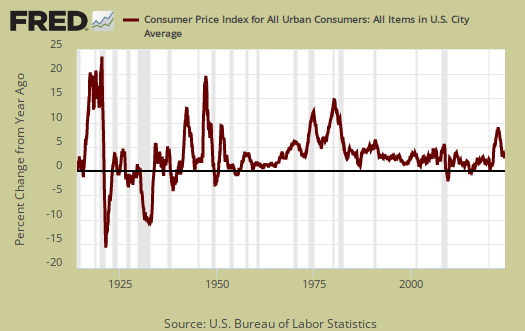
Core inflation, or CPI with all food and energy items removed from the index, has increased 1.7% for the last year. Core CPI is one of the Federal Reserve inflation watch numbers and 2.0% per year is their target rate. While all are predicting interest rates will rise, Federal Reserve Chair Janet Yellen has testified that the low inflation numbers are a a concern since increased interest rates would lower economic activity. Graphed below is the core inflation change from a year ago.

Core CPI's monthly percentage change is graphed below. This month core inflation increased 0.2%.

Energy overall came back from last month's plunge and increased 1.0% for the month. Energy costs are now down -18.8% from a year ago. The BLS separates out all energy costs and puts them together into one index. Gasoline alone increased 2.4% for the month and has declined -32.8% for the year. Fuel oil increased 1.9% for the month, yet is still down -31.2% for the year. Natural gas is down -6.5% from a year ago with a monthly decline of -2.0 %. Electricity increased 0.3% for the month and is up 3.2% for the year. Graphed below is the overall CPI energy index.
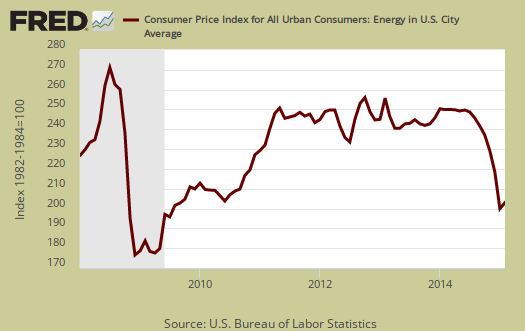
Graphed below is the CPI gasoline index only, which shows gas prices wild ride and new ascent.
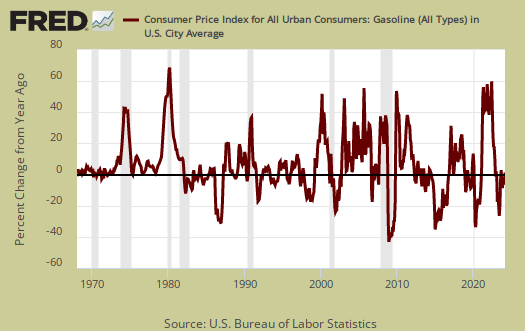
Core inflation's components include shelter, transportation, medical care and anything that is not food or energy. The shelter index is comprised of rent, the equivalent cost of owning a home, hotels and motels. Shelter increased 0.2% and is up 3.0% for the year%. Rent increased 0.3% for the month, 3.5% for the year. This is the national average,, rents in some areas of the country are just soaring. Home prices are increasing as reflected in the cost for home owners increased 2.7% for the past year as well. Graphed below is the rent price index.

Medical care services actually declined -0.2%, the first time since November 1975. Graphed below is the overall medical care index change of 2.3% from a year ago.

Below is a graph of the medical commodities index, which is in large part consists of prescription drug prices. The index increased 0.7% for the month as prescription drugs inflation was 0.6% and the index is up 3.9% for the past year. Notice the beyond belief never ending increases since 1975 in the below graph. Meanwhile Americans are force feed expensive pharmaceutical marketing campaigns to the point that act, by itself, is probably making people sick.

February food inflation was 0.2%. Food and beverages have now increased 3.0% from a year ago. Groceries, a.k.a. food at home, increased 0.1% for the month, and is up 2.9% for the year. Eating out, or food away from home increased 0.3% from last month and is up 3.1% from a year ago.
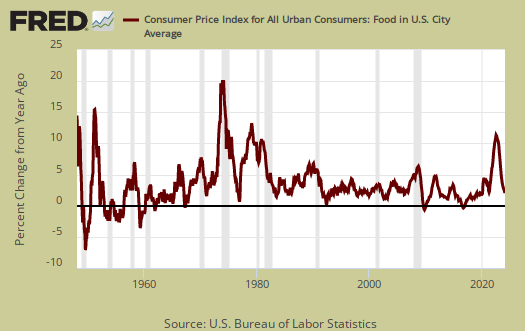
Graphed below is the food at home index, which is deceptive due to the BLS assuming one will substitute items, such as hamburger for steak, when a large price increase occurs.
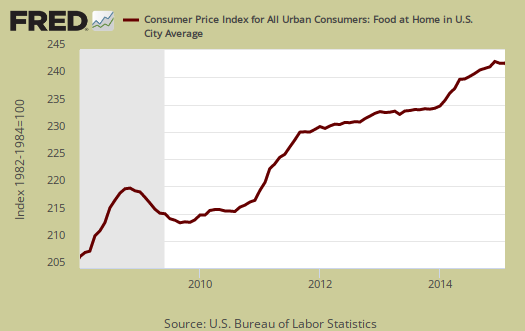
Individual food items so one gets a better feel for what is going on. Beef & veal are up 15.2% for the year with a monthly 0.7% increase.
The BLS released real hourly earnings for February and no surprise with a little inflation, real average hourly wages declined by -0.1%. Real means wages adjusted for inflation. The wage is now $10.54 and has increased 2.1% from a year ago. Weekly real earnings have increased 2.6% for the year.
CPI details
The DOL/BLS does take yearly surveys on where the money goes in the monthly budget, but as one can see, food and energy are significant amounts of the monthly finances. Run away costs in these two areas can break the bank, so can food. Additionally CPI uses substitution, so if flour goes through the roof, somehow we're all just fine with oats and prices didn't really overall increase much. Here is the BLS CPI site, where one can find much more details, information on calculation methods and error margins.
Other CPI report overviews, unrevised, although most graphs are updated, are here. If you're wondering why the graphs display different figures from the text, the graphs calculate percentages from the index and do not round. The actual data from the BLS report does round to one decimal place. In other words, 0.05% is rounded to 0.1%.

implies a big hit to PCE
prices for all commodities less food and energy rose 0.2% in February, the largest jump in more than a year and only the second time since September 2011 that index rose as much as 0.2%...this suggests a similar deflator will be used on retail sales for February when computing personal consumption expenditures of goods for the month, and since retail sales ex groceries and gas stations fell by 0.93%, that implies real personal consumption expenditures of all other goods would be down by more than 1.1% for the month...
rjs
probably not that bad
more goes into PCE beyond gas but I can calculate real when March Personal income comes out. I think Q1 GDP ain't gonna be pretty.
on the other hand
the index for services less energy services was up by just 0.1%, with the 0.3% increase in rent of shelter counting for more than half that index, so the deflator for other February services should be negative...
rjs
February PCE
February PCE is out today. real growth shrunk 0.1% as durables were down 1.1%, non-durables were flat, and services saw a 0.1% increase..
rjs